The Radeon R9 280X Review: Feat. Asus & XFX - Meet The Radeon 200 Series
by Ryan Smith on October 8, 2013 12:01 AM ESTPower, Temperature, & Noise
As always, last but not least is our look at power, temperature, and noise. Next to price and performance of course, these are some of the most important aspects of a GPU, due in large part to the impact of noise. All things considered, a loud card is undesirable unless there’s a sufficiently good reason – or sufficiently good performance – to ignore the noise.
With the Tahiti based 7970GE, we saw AMD push some very high voltages when boosting in order to hit their 1050MHz clockspeed targets. With 280X on the other hand they can back off at least a bit, which should help real world power consumption some.
| Radeon HD 7970/200 Series Voltages | ||||||
| Asus 280X Boost Voltage | XFX 280X Boost Voltage | Ref 7970GE Base Voltage | Ref 7970GE Boost Voltage | Ref 7970 Base Voltage | ||
| 1.2v | 1.2v | 1.162v | 1.218 | 1.175v | ||
On both our stock and factory overclocked 280X cads we see a boost voltage of 1.2v, which as expected is a bit lower than the 1.218v the 7970GE drew under the same conditions.
We also have a quick look at clockspeeds while gaming, although there’s little to report here. Without the ability to see the intermediate clockspeeds on 280X we can only tell whether it’s boosting or not. In every game on both 280X cards, these cards are always in a boost state.
| Radeon R9 280X Average Clockspeeds (Reported) | ||||
| Asus 280X | XFX 280X | |||
| Boost Clock | 1070MHz | 1000MHz | ||
| Metro: LL |
1070MHz
|
1000MHz
|
||
| CoH2 |
1070MHz
|
1000MHz
|
||
| Bioshock |
1070MHz
|
1000MHz
|
||
| Battlefield 3 |
1070MHz
|
1000MHz
|
||
| Crysis 3 |
1070MHz
|
1000MHz
|
||
| Crysis: Warhead |
1070MHz
|
1000MHz
|
||
| TW: Rome 2 |
1070MHz
|
1000MHz
|
||
| Hitman |
1070MHz
|
1000MHz
|
||
| GRID 2 |
1070MHz
|
1000MHz
|
||
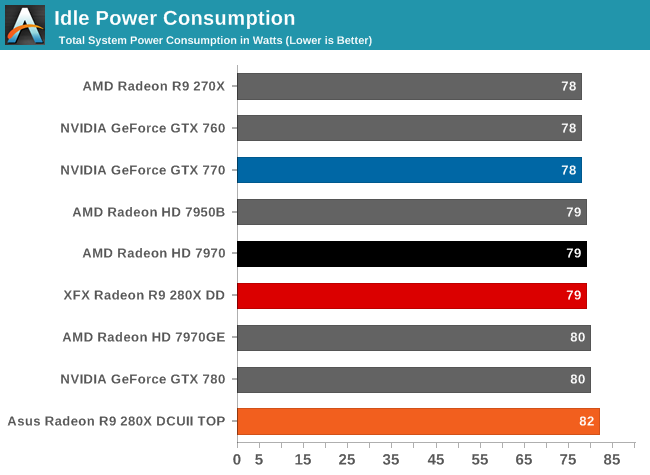
One of the advantages of our new testbed is that IVB-E and the testbed as a whole draw a lot less power under load and idle. This makes it easier to isolate video card power consumption from the rest of the system, giving us more meaningful results.
In this case though there are no surprises to be found with idle power consumption given just how similar all of these cards are while idling.
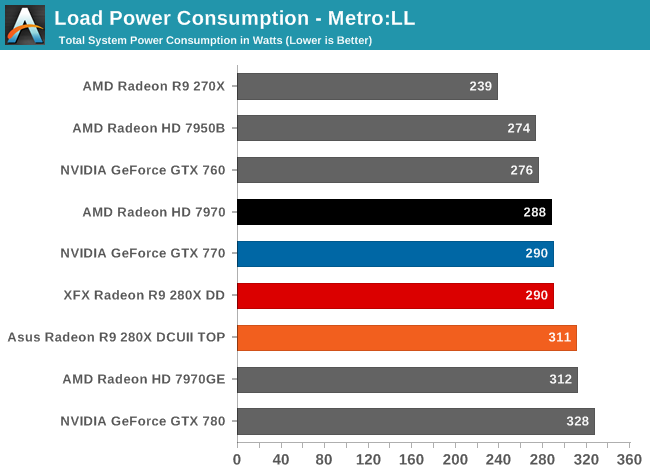
Up next is our new gaming power load test, for which we’re using Metro: Last Light. This was initially calibrated against a GTX 780, in which we found that Metro is both highly repeatable, runs long enough (when looped) to fully exercise a video card, and the load it puts on video cards as a percentage of allowable TDP is considerably average among all games.
To that end Metro paints an interesting picture of power consumption for the 280X. Despite its identical to the 7970GE TDP of 250W, real power consumption is down versus that card, and at least at the wall is identical to the 230W GTX 770 (not that NVIDIA and AMD measure TDP in the same way). What this tells us is that alongside their similar on average performance, the GTX 770 and 280X also draw similar amounts of power under gaming workloads.
Meanwhile Asus’s 280X draws more power, closer to a 7970GE, but this is not unexpected for a factory overclock.
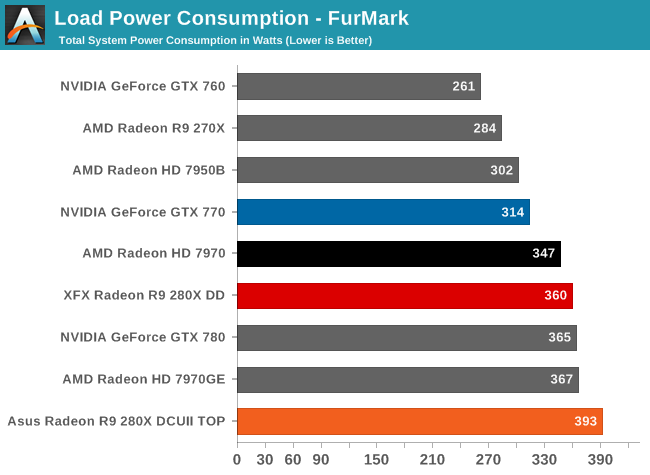
FurMark on the other hand, being the TDP buster that it is, paints a different picture of the situation. The 280X can generate and sustain a much higher power workload than the comparable GTX 770, and still more yet than the original 7970. FurMark isn’t a game and that’s why we primarily use it as a diagnostic tool as opposed to a real world test, but it does lend credit to the fact that when pushed to its limits 280X is still a high TDP part.
At the same time because FurMark is such a consistent TDP test, the outcome of this test leads us to believe that the Asus 280X isn’t just overclocked, but Asus has also increased their TDP/PowerTune limits to avoid bottlenecking there. The power consumption here is consistent with the XFX card having its PowerTune limit turned up, which implies that the Asus card is closer to a 300W card under maximum load. The gaming performance is very good as we’ve seen, but there is a cost.
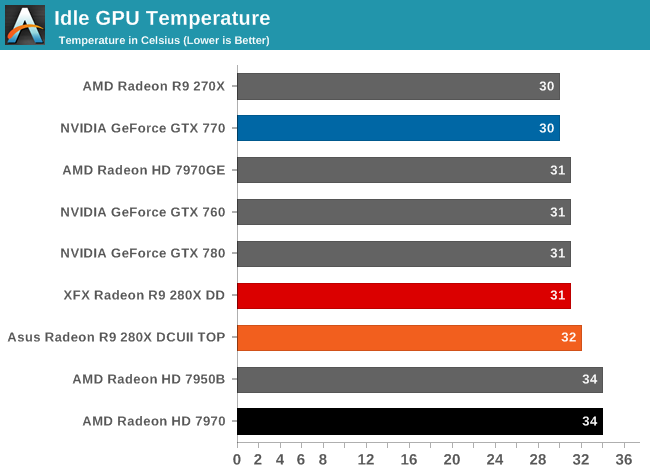
Like most open air coolers, our 280X cards do well enough here. 31C-32C is where most cards will idle at.
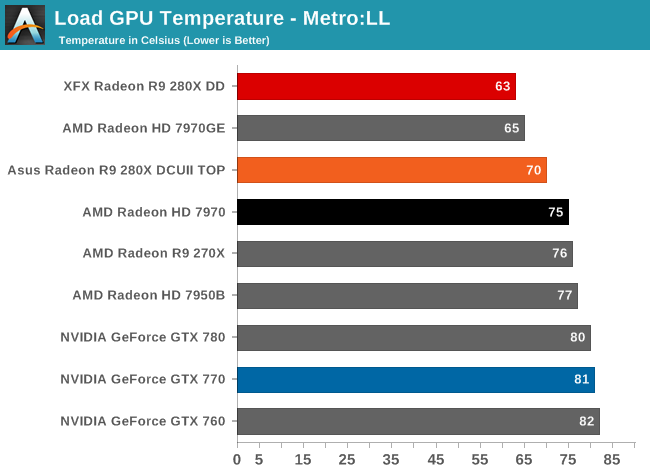
Of all of the Tahiti cards in this article, it’s our XFX 280X that delivers the best temperatures under load. 63 is downright chilly for a 250W card, indicating the card has plenty of thermal headroom. The Asus card by comparison doesn’t fare quite as well, but we don’t even bat an eye until we hit 80C.
It’s worth noting that both cards also do well against the GTX 700 series here, though this is entirely down to the use of open air coolers. As good as these coolers are you won’t be stuffing either card in a cramped case with limited ventilation; for that you need a blower.

As to be expected FurMark drives up our temperatures further. The XFX 280X is no longer our coolest card overall – that goes to the Tahiti based 7970GE – but of the two 280X cards it’s still the cooler one. The Asus meanwhile reaches 76C, which is still a reasonable temperature but it does mean the card doesn’t have a ton of thermal headroom left on its default fan curve. Though if our suspicions are right about the Asus card operating at a higher TDP, then this would at least explain in part the higher temperatures.
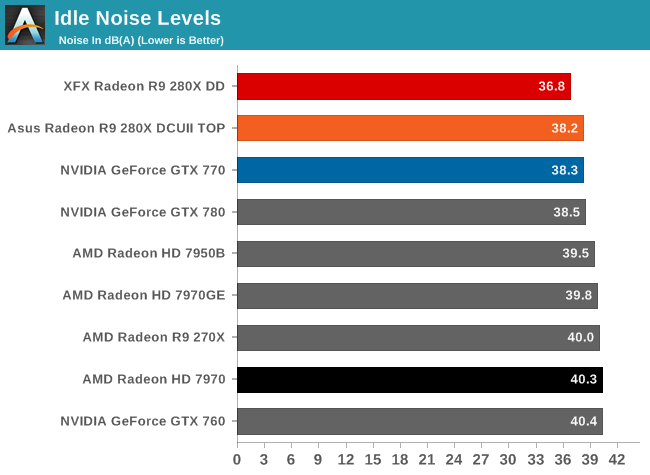
With this being the first article on our new testbed we re-ran the XFX result thrice to make sure we weren’t making any errors, but indeed these results are accurate. Whereas every other card dropped off at around 38dB the XFX 280X bested them with 36.8dB. Even among open air coolers this is a very impressive card at idle. In comparison the Asus is merely average in its near-silence.

Once we start looking at load noise levels however, the picture changes completely. As impressive as the XFX card was at idle, it doesn’t begin to compare to the Asus card under load. We have a card that’s channeling nearly 250W of heat out and away on a sustained basis, and yet for all of that work it generates just 41.5dB(A) of noise on our testbed. This is simply absurd in the most delightful fashion. Most of the cards in our data collection idle at just 2dB lower than this, never mind noise under load. As a result this is incredibly close to being functionally silent; in the case of our testbed the Asus card isn’t even the principle noise source when it’s under load.
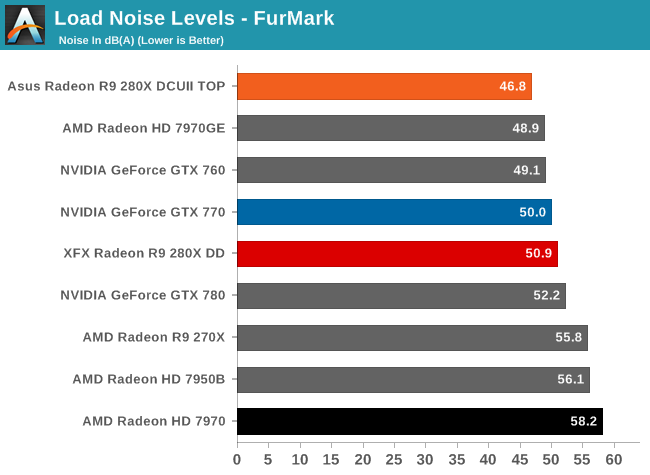
Last, but not least we have noise under FurMark. Although the Asus eventually has to ramp up and leave it’s low-40s comfort zone, at 46.8dB it’s still the quietest card around by 2dB(A). The XFX 280X meanwhile is merely average, if not a tinge worse for an open air cooler. 50.9dB(A) is plenty reasonable, it just pales in comparison to the Asus card.










151 Comments
View All Comments
alfredska - Wednesday, October 9, 2013 - link
Yes, I made a couple mistakes in trimming the fat from Ryan's writing. I should have done another proof-read myself. This wasn't the point of my post, though.Ryan's review is littered with sentence pauses that drastically slow down your ability to read the article. Some examples are: starting too many sentences with words like "ultimately" or "meanwhile"; making needless references to earlier statements; using past or present perfect tense when just past or present tense is appropriate. I wrote the above example hoping that Ryan would put it next to his own writing and see whether he can 1) read it faster, and 2) retain more information from this version.
I can accept a misspelling here and there and even some accidental word injections of which I was guilty. The fluidity needs work though. If the reader cannot glide easily between paragraphs, they will stop reading and just look at pictures.
chuck.norris.and.son - Tuesday, October 8, 2013 - link
tl:dr :( blablablaCan't you nail it down: AMD or Nvidia? Which GFX card should i buy to play Blockbuster like BF 4?
ShieTar - Tuesday, October 8, 2013 - link
How about not buying any new GFX card and investing the savings into books in order to improve your reading skills?Will Robinson - Tuesday, October 8, 2013 - link
Radeon 280X will be the sweet spot card to get for BF4.R9 290X will be the open class champ over GTX780 I suspect.
piroroadkill - Tuesday, October 8, 2013 - link
The best AMD card you can buy with your money, simply because Battlefield 4 will eventually feature the Mantle renderer which is for GCN cards only, and will probably be a killer feature.hrga - Tuesday, October 8, 2013 - link
Most moronic branding ever (at least the one to be overrun). They cutout vanilla 7850 or top end 7950 from the HD7000 lineup and call it with confusing R9/R7, unrealistically stupid marketing where nothing material stand behind those names.Another rebranding?
- Yes. [thinking. What the heck did you expect guys]
Not most successful?
- [thinking. depends on POV] Well, it's here to milk the most cash as our CPU business didnt produced anything valuable for three years. And we also must have something interesting to present in our slideshow presentation for investors. If we couldn't afford to produce whole new lineup we could always produce yet another rebranded line just like nvidia. We always learn from our (cartel) competition, and customers don't seem to have any objections on that matter.
So that's why you retain those moronically high prices?
- We just adjust that according to our competition (cartel)
But you never lower prices for HD7870 which today celebrates its second birthday and is produced on highly matured 28nm for at least six month. Instead you just rebranded it for second time after HD8860, so now we have R9 270X too. Don't you think you're customers would like to see some new designs while putting old products on discount prices?
Or at least you could introduce that R9 270, which is same old HD7870, with lower prices than todays HD7870 retail prices are?!
Instead of higher up prices for same performance (source Newgg http://imageshack.dk/imagesfree/xLh43741.jpg).
And why the heck R9 desination for this mediocre mainstream product?! You could weaselishly sell this c-rap at the end of 2011, but "Hello AMD!" It the end of 2013.
Pitcairn used in HD7800/HD8800 seriesis is smaller chip than Evergreen in HD5800, which only three years ago was produced on troublesome early 40nm process while this is two year old design now produced on highly mature TSMC 28nm-HK node for at least six month with far better yields? HD5850 had same or even lower prices at EOL (only year after introduction) than todays two year old Pitcairn desing. How do you explain that?
- Well ...Milking you know ... When you have good cartel environment like we have competing with nvidia we could sky rocket prices. And you know even crappy Intels Knights Corner chips today produced at 22nm would be any cheaper because Intel knows how to milk moneys on their tick-tock performance introductions and they certainly would gave up that experience in case of "Chip Previously Known as Larabee" (CPKL)
labodhibo - Tuesday, October 8, 2013 - link
Must read this.. totally different perspective:http://www.techspot.com/review/722-radeon-r9-270x-...
AssBall - Tuesday, October 8, 2013 - link
Well done review. I kinda like what Asus did with its 280x version.Typo: "Asus calls it “CoolTech” and it’s essentially an effort to build a fan that’s blow a an axial fan and a blower (radial) fan at the same time,"
[blow -> both?]
zlandar - Tuesday, October 8, 2013 - link
This is why I wanted the Asus 770 card also in the recent 770 GTX roundup. The cooler design seems superior for single GPU purposes as long as you have the room for it in your case.AxialLP7 - Tuesday, October 8, 2013 - link
Not trying to be AFC, just want to make sense of this: "Asus calls it “CoolTech” and it’s essentially an effort to build a fan that’s blow a an axial fan and a blower (radial) fan at the same time, explaining the radial-like center and axial-like outer edge of the fan." Can someone help? This is in the "ASUS RADEON R9 280X DIRECTCU II TOP" section...